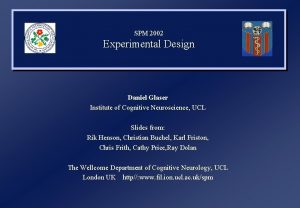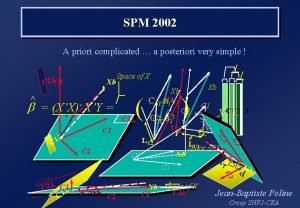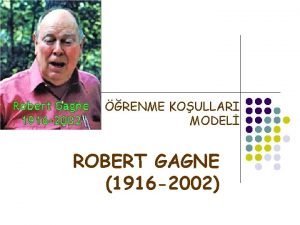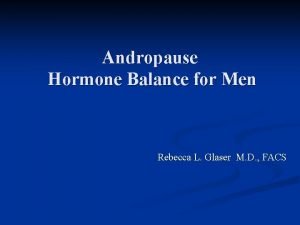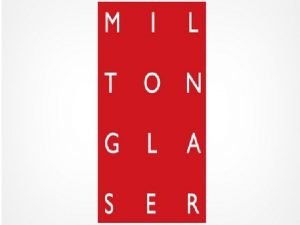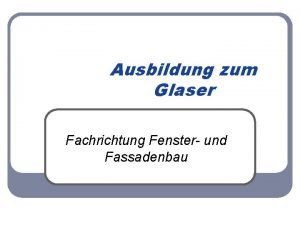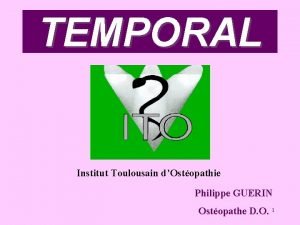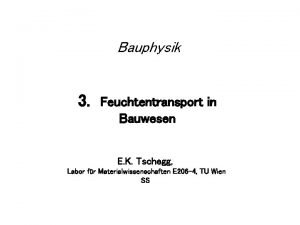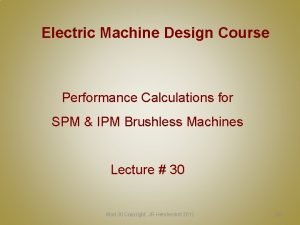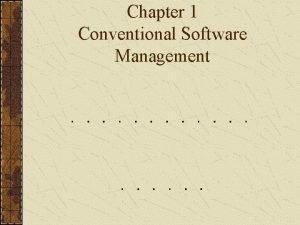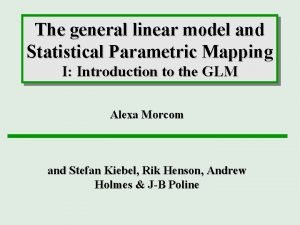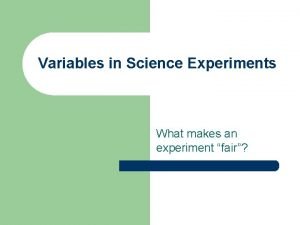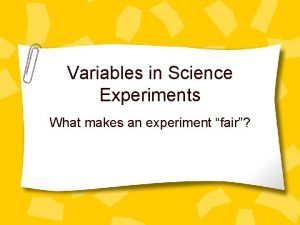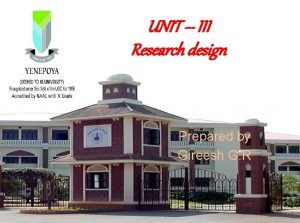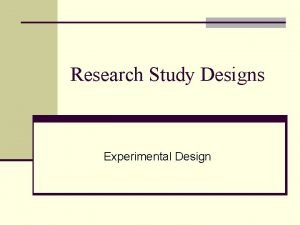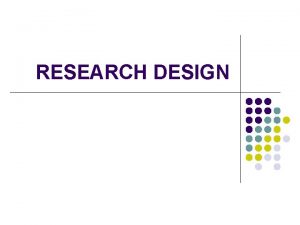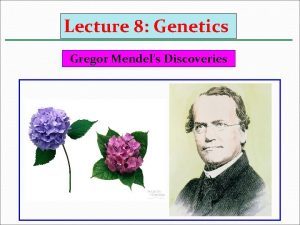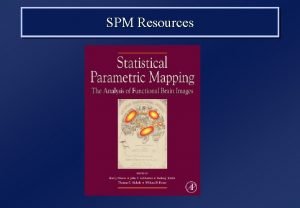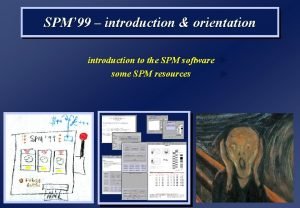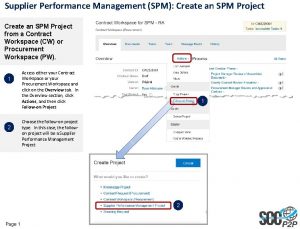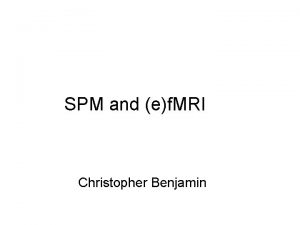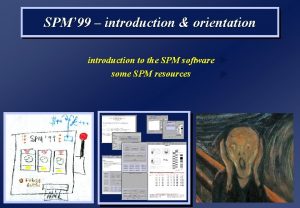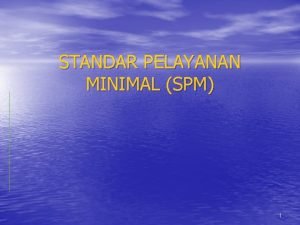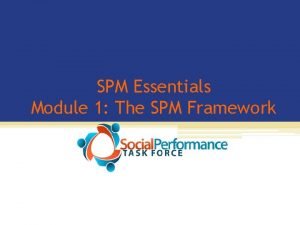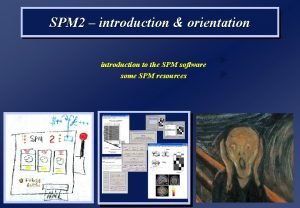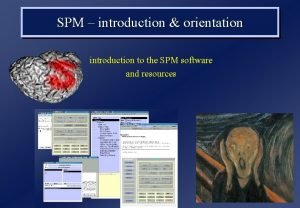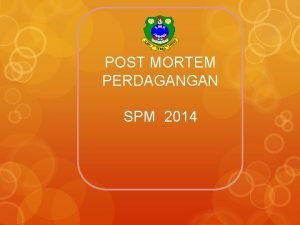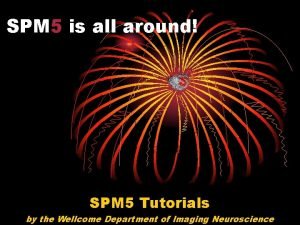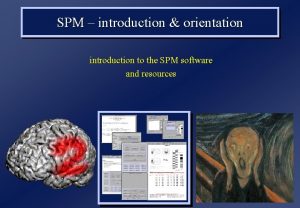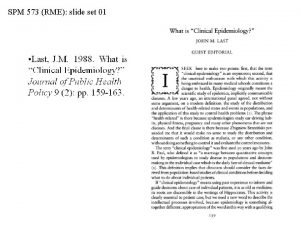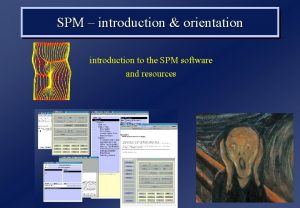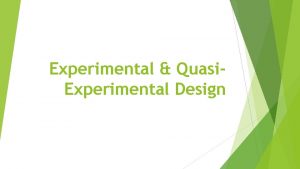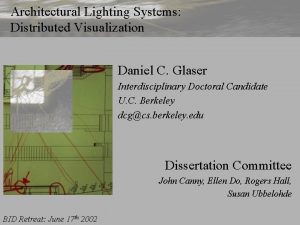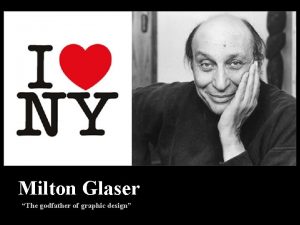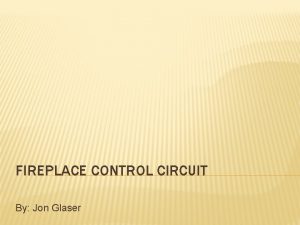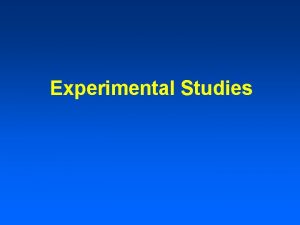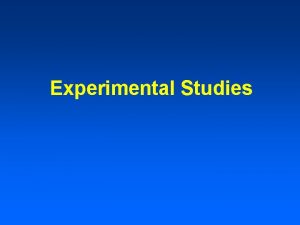SPM 2002 Experimental Design Daniel Glaser Institute of







![A parametric analysis The [nonlinear] effect of time assessed with the SPM{T} A parametric analysis The [nonlinear] effect of time assessed with the SPM{T}](https://slidetodoc.com/presentation_image/35d964af3e165c9144540768a59d4ca7/image-8.jpg)




















- Slides: 28

SPM 2002 Experimental Design Daniel Glaser Institute of Cognitive Neuroscience, UCL Slides from: Rik Henson, Christian Buchel, Karl Friston, Chris Frith, Cathy Price, Ray Dolan The Wellcome Department of Cognitive Neurology, UCL London UK http//: www. fil. ion. ucl. ac. uk/spm

Data transformations Kernel Design matrix Smoothing General linear model Image time-series Realignment Statistical parametric map (SPM) Statistical inference Normalisation Gaussian field theory p <0. 05 Template Parameter estimates

Stimuli SPM{T} + isoluminant stimuli (even) + V 5 speed isochromatic stimuli (odd)

A taxonomy of design • Categorical designs Subtraction Conjunction - Pure insertion and cognitive subtraction - Differential event-related f. MRI - Testing multiple hypotheses • Parametric designs Linear Nonlinear - Cognitive components and dimensions - Polynomial expansions and neurometric functions - Nonlinear event-related f. MRI • Factorial designs Categorical Parametric - Additive factors and pure insertion - Psychopharmacological designs - Adaptation, modulation and dual-task inference - Linear and nonlinear interactions - Psychophysiological Interactions

A categorical analysis Experimental design Word generation G Word repetition R RGRGRG G - R = Intrinsic word generation

BOLD EPI f. MRI at 2 T, TR 3. 2 sec. Words presented every 16 secs; (i) studied words or (ii) new words Differential event-related f. MRI Parahippocampal responses to words SPM{F} testing for evoked responses SPM{F} testing for differences studied words new words Peri-stimulus time {secs}

Cognitive Conjunctions Components Object Recognition Phonological Retrieval Visual Processing R P V Tasks Object naming Colour naming R, P, V, Rx. P P, V Object viewing Colour viewing R, V V Object recognition responses (R) The Conjunction [ R, V - V ] & [ R, V, P, Rx. P - V, P ] R, Rx. P & R = R viewing naming
![A parametric analysis The nonlinear effect of time assessed with the SPMT A parametric analysis The [nonlinear] effect of time assessed with the SPM{T}](https://slidetodoc.com/presentation_image/35d964af3e165c9144540768a59d4ca7/image-8.jpg)
A parametric analysis The [nonlinear] effect of time assessed with the SPM{T}

Nonlinear parametric responses: Inverted ‘U’ response to increasing word presentation rate in the DLPFC SPM{F} 42 wpm Regression and design matrix

Neurometric functions: Extrastriate responses to stimuli of increasing duration: Stimulus-specific or contextual effects? SPM{F} Adaptation of neuronal responses time{ms} Attentional modulation 0 exposure duration {ms} 800

Hemodynamic responses to words in the left peri-auditory region • • • BOLD EPI T 2* at 2 Tesla TR = 1. 7 s 34 s epochs of aurally presented words at 0, 15, 30, 60 and 90 words per minute 1200 volume time-series State-related responses Event-related 60 wpm 32 secs Peri-stimulus time SPM{F}

Context-sensitive responses time stimulus n-1 stimulus n+1 interaction between stimuli response n

Volterra series - a general nonlinear input-output model input u(t) Simulated input kernel estimates response y(t) nonlinear saturation

Nonlinear hemodynamic responses kernel coefficients - h SPM{F} p < 0. 001 SPM{F} testing H 0: kernel coefficients = h = 0

Nonlinear hemodynamic responses - implications Hemodynamic response interference in terms of the effect of a prior stimulus nonlinear saturation

Rate-dependent responses: Processing one stimulus in the context of others ERPs - single words 42 wpm Integrated response 1400 ms 42 wpm 600 ms 1400 ms 700 ms nonlinear interactions 84 wpm ? Rate {wpm}

Nonlinear BOLD responses left right BOLD Linear r. CBF responses r. CBF Peri-auditory responses in PET and f. MRI Word presentation rate

A factorial analysis Time x condition interactions (i. e. adaptation) assessed with the SPM{T}

Interactions and context-sensitive effects A 2 x 2 layout Context 1 (no naming) 1 2 Context 2 (naming) 3 4 without A & with A (e. g. . recognition) interaction effect (A x Context) A A task 1 2 Context 1 3 4 Context 2

Interaction effects in the left inferotemporal region A PET study of object naming V R P Rx. P Conjunction (name object - shape) & (view object - shape) = (R + Rx. P) & R = R Interaction (name object - shape) - (view object - shape) = (R + Rx. P) - R = Rx. P Object-specific activations adjusted r. CBF Components Visual processing Object recognition Phonological retrieval Interaction Context: no naming

Psychopharmacological studies • PET, 6 subjects, 6 conditions • 3 x 2 factorial design, Buspirone x Memory left parahippocampal responses sub- suprapreacutepre post- acute post

Dissociating the direct and modulatory effects of context Context-sensitive effect = S x N response A direct effect of context = C time C frequency response time S frequency

Responses in the right posterior superior temporal region to increasing rates (15 - 90 wpm) of word production r. CBF {ml/dl/min} 84 77 whilst repeating words and producing new ones

Interactions between set and event-related responses: Attentional modulation of V 5 responses attention to motion attention to colour

Non-linear parametric interactions Increasing word presentation rate in a subject and patient with a CVA Differential responses in the left hippocampus SPM{F}

Psychophysiological interactions Context X source target Set stimuli Modulation of stimulus-specific responses source target Context-sensitive connectivity source target

Psychophysiological interactions in the right inferotemporal region: Modulation of face-selective responses by PPC SPM{Z} Face stimuli PPC IT adjusted r. CBF Faces Objects medial parietal activity

Psychophysiological interactions: SPM{T} V 5 activity Attentional modulation of V 2 - V 5 contribution Attention V 2 V 5 activity time attention no attention V 2 activity
 Non experimental design vs experimental
Non experimental design vs experimental Spm 2002
Spm 2002 Spm 2002
Spm 2002 Experimental vs non experimental
Experimental vs non experimental What is quasi experimental research
What is quasi experimental research Experimental vs non experimental research
Experimental vs non experimental research Experimental vs non experimental
Experimental vs non experimental Zihinsel beceriler gagne
Zihinsel beceriler gagne Dr david glaser
Dr david glaser Dr rebecca glaser
Dr rebecca glaser Born june 26
Born june 26 Fassadenbau vom glaser
Fassadenbau vom glaser Canal de fallope
Canal de fallope Glaser verfahren
Glaser verfahren Samantha cogging
Samantha cogging Late design breakage in spm
Late design breakage in spm Parametric map
Parametric map Independent variable science
Independent variable science Experimental design independent and dependent variables
Experimental design independent and dependent variables Solomon four group design
Solomon four group design Quasi experimental design example
Quasi experimental design example Experimental study design
Experimental study design Non experimental research topics
Non experimental research topics Non-experimental design definition
Non-experimental design definition Quasi experiment disadvantages
Quasi experiment disadvantages Basic principles of experimental design
Basic principles of experimental design Are freckles recessive
Are freckles recessive Mendelian principles of genetics
Mendelian principles of genetics Mendel's experimental design
Mendel's experimental design

